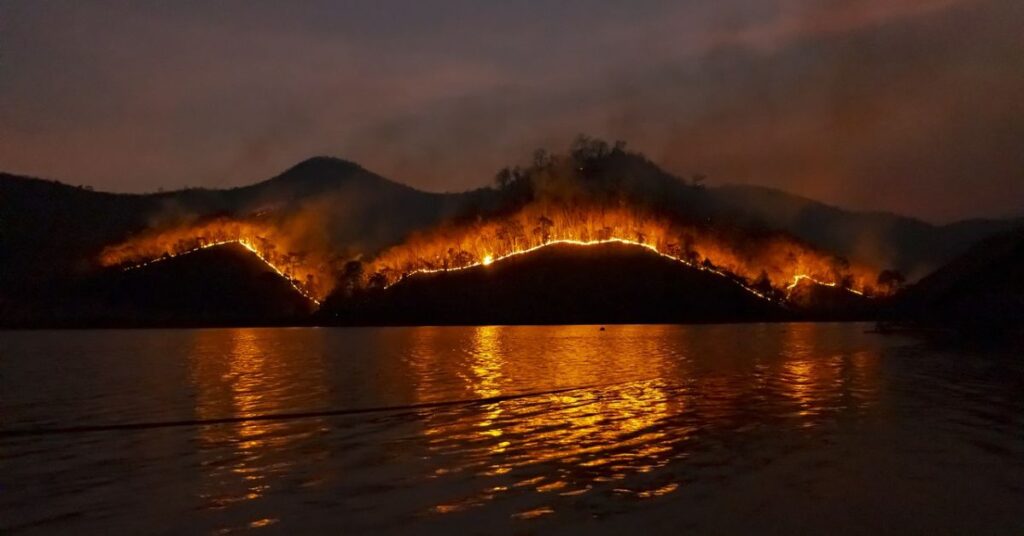What are the causes behind large wildfires like the Bench Lake Fire? How do they spread, and what is being done to control them? Wildfires are a natural but devastating force, and understanding them is key to supporting affected communities and ecosystems.
Overview of the Bench Lake Fire
The Bench Lake Fire, currently burning near Redfish Lake in Idaho’s Sawtooth National Forest, has rapidly grown to over 2,500 acres as of September 2024. This fire is a serious concern due to its proximity to popular recreation spots, residential areas, and ecologically sensitive environments. Efforts to contain it have become a priority for local and federal agencies. The fire, which began in late summer, continues to challenge firefighters due to difficult terrain and weather conditions.
Causes and Initial Spread
The origins of the Bench Lake Fire are currently under investigation, but early reports suggest that dry conditions, strong winds, and human activity could have contributed to its rapid spread. Wildfires like this one are often a result of a combination of environmental factors that create a perfect storm for ignition and rapid growth. The area surrounding Bench Lake has been experiencing drought-like conditions, which have made the vegetation highly flammable. In combination with high winds, fires can quickly get out of control, jumping from treetop to treetop or spreading across dry grasslands.
Containment Efforts and Strategies
Containing a wildfire as large as the Bench Lake Fire is a complex process involving coordination between multiple agencies, including the U.S. Forest Service, local fire departments, and specialized wildfire management teams. Firefighters are using both direct and indirect methods to control the blaze. Direct firelines involve creating barriers by removing vegetation to stop the fire’s spread, while indirect firelines take advantage of natural barriers like rivers or ridgelines.
As of mid-September, fire crews have made significant progress in constructing firelines around the fire’s perimeter. They are also clearing hazardous areas, particularly near Fishhook Creek and the Decker Flats Road. However, the fire remains only partially contained, with approximately 13% of the blaze under control.
One of the major challenges in containing the Bench Lake Fire has been the difficult terrain. The fire is burning in rugged, mountainous areas, making it hard for ground crews to access. Additionally, heavy machinery is being used to clear dense vegetation and create more accessible routes for firefighting operations. This machinery has been instrumental in keeping the fire from spreading further into populated areas, such as the nearby Stanley Ranger Station and the Fish Hatchery.
Impact on Local Communities and Ecosystems
The Bench Lake Fire has had a significant impact on the surrounding communities. Evacuation orders have been issued for certain areas, and residents are being kept informed through emergency alerts. Many recreational sites, including campsites and hiking trails, have been closed to the public for safety reasons. Local businesses that depend on tourism are also feeling the effects, as fewer visitors are venturing into the area due to the smoke and fire danger.
From an ecological standpoint, wildfires like the Bench Lake Fire can have both positive and negative effects. In the short term, the fire is devastating, destroying habitats and releasing large amounts of carbon into the atmosphere. However, wildfires are also a natural part of many ecosystems, helping to clear out old vegetation and promote new growth. In the long run, the area around Bench Lake may see a resurgence in plant and animal life as the landscape regenerates.
Also read: Top 4 Fire-Prone Areas in Every Modern Commercial Building
The Role of Weather in Fire Behavior
Weather plays a critical role in the behavior of wildfires, and the Bench Lake Fire is no exception. Over the past few weeks, the region has experienced warmer-than-average temperatures, which have contributed to the fire’s growth. Temperatures in the lower 90s were recorded over the fire area in mid-September, creating conditions that made it difficult for firefighters to gain control.
Firefighters are hoping that cooler temperatures and increased humidity in the coming weeks will help slow the fire’s progress. However, there is always the risk that strong winds could reignite flames or cause the fire to jump containment lines. Weather conditions are being closely monitored, and firefighting strategies are being adjusted accordingly.
Community Support and Preparedness
One of the key components of managing a wildfire is keeping the local community informed and prepared. Residents of Custer County, where the fire is located, have been encouraged to sign up for emergency alerts through the CodeRED system. This system provides real-time updates on the fire’s progress and any evacuation orders.
The community has also rallied together to support firefighters and those who have been displaced by the fire. Local businesses have been donating supplies, and temporary shelters have been set up for evacuees. The spirit of cooperation is essential in times like these, as everyone works together to protect lives and property.
The Long Road to Recovery
Even after the Bench Lake Fire is fully contained, the recovery process will take time. The immediate focus will be on preventing further damage, such as landslides or floods, which can occur in areas where vegetation has been burned away. Efforts will also be made to restore habitats and support the return of wildlife to the area.
For residents and businesses affected by the fire, recovery will also be a long-term process. Some structures may need to be rebuilt, and the local economy will need to rebound from the loss of tourism during the busy summer season. However, the resilience of the community and the natural beauty of the Sawtooth National Forest will ensure that the area recovers in the years to come.
Conclusion:
The Bench Lake Fire serves as a reminder of the power of nature and the importance of preparedness. While wildfires can cause significant destruction, they also offer opportunities to learn and improve. Communities near wildfire-prone areas can take steps to reduce the risk, such as clearing vegetation around homes and staying informed about fire conditions.
As the firefighting efforts continue, the hope is that the Bench Lake Fire will be fully contained soon, allowing residents to return home and the forest to begin its natural process of regeneration.







